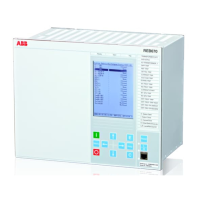This solution is especially suitable for the station arrangements, which require the
dynamic zone selection logic (that is, so called CT switching).
6.1.3.10 Mechanical lock-out function
M12119-3 v1
M12119-4 v3
It is sometimes required to use lock-out relays for busbar protection operation.
The IED has built-in feature to provide either self-reset or latched tripping in case of
busbar protection operation. Which type of trip signal each zone will issue is
determined by a parameter setting DiffT
ripOut which can be set either to SelfReset or
Latched. When Latched is selected the trip output from the IED will only reset if:
1. Manual reset command is given to the IED
2. DC power auxiliary supply to the IED is interrupted (that is, switched-off)
However, if it is required to have mechanically latched tripping and lock-out in the
circuit breaker closing circuit, then it is recommended to use one dedicated lockout
IED for each bay. Such mechanical lock-out trip IEDs are available in the
COMBIFLEX range (for example RXMVB2 or RXMVB4 bistable IEDs alternatively
MG6 (hand reset contact) IEDs).
From the application point of view lock-out trip IEDs might have the following
drawbacks:
• The trip contacts will remain closed. If the breaker would fail to open the tripping
coil will be burnt and the DC supply short-circuited.
• The trip circuit supervision (TCS) IEDs will reset and give alarm for a failure in
the trip circuit if the alarm is not opened by the lock-out IED or a double trip
circuit supervision is recommended where the trip circuit is supervised with two
alternatively, TCS IEDs.
6.1.3.11 Contact reinforcement with heavy duty relays
M12120-3 v1
M12120-4 v3
There is sometimes a request for heavy duty trip relays. Normally the circuit breaker
trip coils, with a power consumption of 200 to 300 W, are provided with an auxiliary
contact opening the trip circuit immediately at breaker tripping. Therefore, no heavy
duty breaking capacity is required for the tripping relays. Nevertheless heavy duty trip
relays are still often specified to ensure trip circuit opening also if the circuit breaker
fails due to a mechanical failure or a lack of energy for operation. This can particularly
occur during site testing. In this case it is recommended to use COMBIFLEX RXMH 2
or RXMVB 2 or MG6 heavy duty relays.
6.1.3.12 Trip circuit supervision
M12121-3 v3
1MRK 505 370-UUS A Section 6
Differential protection
Busbar protection REB670 2.2 ANSI 135
Application manual

